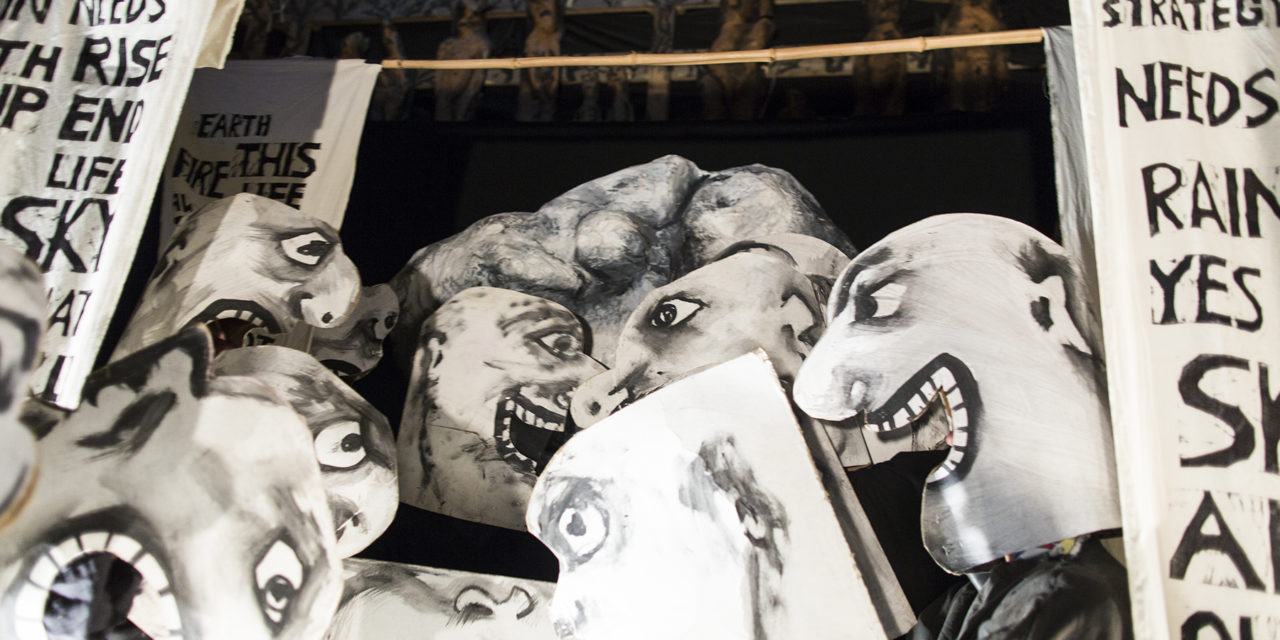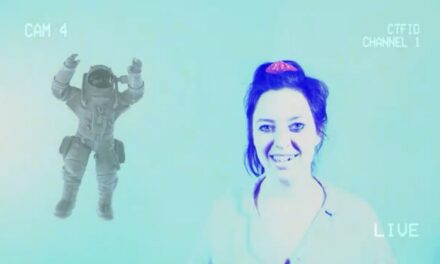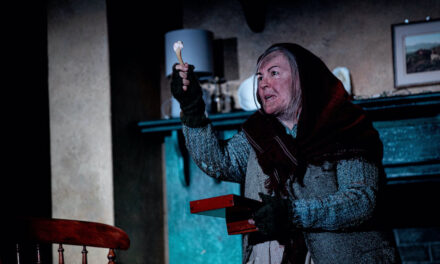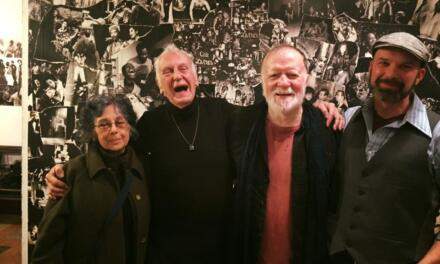As The Basic Byebye Show comes to an end, a pair of enormous papier mâché angel’s wings protruding from the edges of the diminutive proscenium begin to beat, as if they might carry the stage and all it has contained away to some more palatable and purifying paradise. It is a gesture of valediction that perfectly captures the exultantly critical ethos of Bread and Puppet Theater’s work, which always concerns bidding farewell to the world as it is and charting a course toward the world as it could and should be.
Bread and Puppet Theater has been making anarchic, utopian, anticapitalist, puppet shows on an increasingly massive scale since its founding in 1963 on Manhattan’s Lower East Side by German immigrant Peter Schumann. In 1974 the company relocated to a farm in Glover, Vermont, where their two-day Domestic Resurrection Circus took place every summer until 1998. They continue to tour regularly, bringing both “good” and “bad” puppet shows to communities across the US and abroad. Good puppet shows tend to be more uplifting, more riotous in tone, while bad puppet shows might be more somber and more heavily inflected by the latest calamities in the headlines. Performances are always followed by the serving of course, delicious rye bread, traditionally baked by Schumann himself. Like his puppet shows, Schumann’s bread is not easily chewed and swallowed; both offerings require effort to consume, and both are more nourishing for it. Schumann has said that “our bread and our theater belong together. For a long time, the theater arts have been separated from the stomach. The theater was entertainment. Entertainment was meant for the skin. Bread was meant for the stomach.” In other words, his is an art of and about essential human needs, art meant to be eaten.
The Basic Byebye Show is a “bad” puppet show, most explicitly confronting the contemporary scourges of climate change and unchecked gun violence. Framed by fabric printed with individual words connected to some fundamental aspect of existence ranging from the material (“Earth,” “Rain,” “Air”) to the spiritual (“Resist,” “Awake,” “End”), The Basic Byebye Show’s stage is traversed by blocky black-and-white puppets modeled on Albrecht Dürer figures that speak mainly in squawks and other zany, prelinguistic utterances as they illustrate various losses and transformations. A birch forest grows and its branches are lost to an ice storm. An earthquake rocks a city of skyscrapers. The masses march through the streets armed with assault rifles. Dürer is famous for his 15th century series of Apocalypse woodcuts based on imagery from the final book of the Bible, which makes him an apt inspiration for Bread and Puppet’s meditation on the end times we in Trump’s America appear to be living through at present.
Punctuated by voices calling goodbye while hands wave handkerchiefs in the style of train station sendoffs in days of yore, The Basic Byebye Show unfolds in a sequence of episodes, some more poetically abstract, others more on the crude side. Cardboard iterations of the Four Horsemen, Death, Famine, War, and Pestilence, ride through the playing space to the accompaniment of morose violins and a discordant orchestra of nonsense instruments, but the sharpest, funniest, and most devastating episode involves a fifteen-foot James Madison puppet serving as a “representative of the founding fathers” and his “holy cow,” played by two puppeteers in a cow costume. Madison brandishes a copy of the Second Amendment, with which he impregnates said cow. Years later, the AK-47 is born and is delivered into the hands of the citizenry. Mass carnage ensues. Holy cow.
Though one of the largest and most affecting puppets that makes an appearance in The Basic Byebye Show is the face of a bewildered and despairing angel silently cradling its head in its hands, Schumann’s approach to the apocalypse is holistic. The word “apocalypse,” after all, means “revelation.” In the Book of Revelation, angels arrive to herald such unique cataclysms as “hail and fire mixed with blood,” the opening of a bottomless pit that belches enough smoke to darken the sun, and a plague of locusts with the teeth of lions, the tails of scorpions, and the hair of women. Yet these trials represent merely a convulsion the world must experience before welcoming the second coming of Christ. Good ultimately triumphs over evil, a new way forward is revealed, and life begins anew.
Our enlightened puppet friends have a similar message to proclaim. Saying goodbye to things that have outlived their usefulness, like the Second Amendment, is a natural part of life, they tell us. Saying goodbye to things that have become self-destructively harmful, like capitalism itself, might be difficult, but when we face a choice between taking our leave of either an economic system or the planet that system is ravaging, the choice is clearly between survival and the lake of fire, and therefore ought to be an easy one. The puppets’ allegorical depiction of the situation humankind now finds itself in is not simplistic; it is simply, plainly, frighteningly true.
Schumann’s interest in appropriating the conventions of such older religious theatrical traditions as medieval passion plays has always distinguished him from his avant-garde contemporaries, and here his engagement with one of our most violent and mystical religious texts is shockingly suitable for this violent and mystifying moment in American history. Taking our bit of bread at the end of The Basic Byebye Show feels very much like the celebration of an alternative Eucharist. Whether or not we count ourselves among the faithful, we leave this Bread and Puppet performance nourished, as always, in both body and soul.
The Basic Byebye Show
Bread and Puppet Theater
Icebox Project Space
Philadelphia
This review was first posted on Broad Street Review. Reposted with permission of the author. For original article, click here.
This post was written by the author in their personal capacity.The opinions expressed in this article are the author’s own and do not reflect the view of The Theatre Times, their staff or collaborators.
This post was written by Jessica Rizzo.
The views expressed here belong to the author and do not necessarily reflect our views and opinions.


















